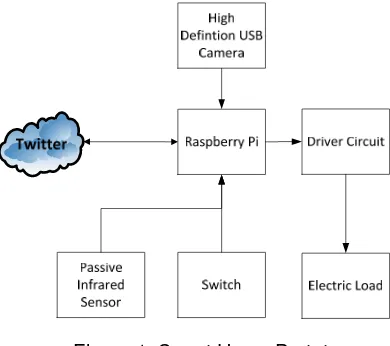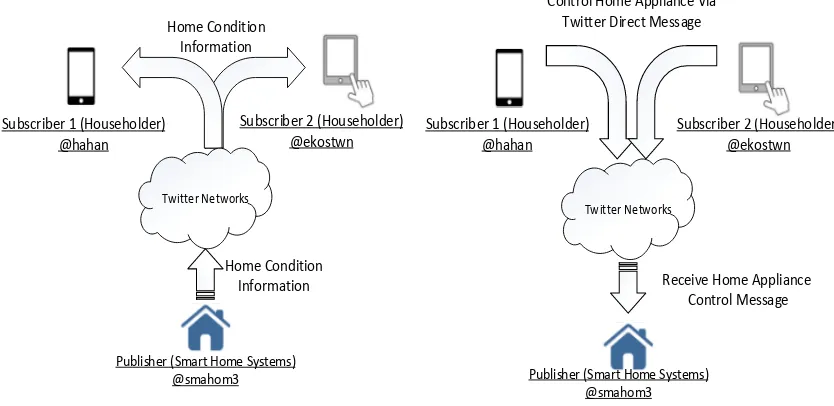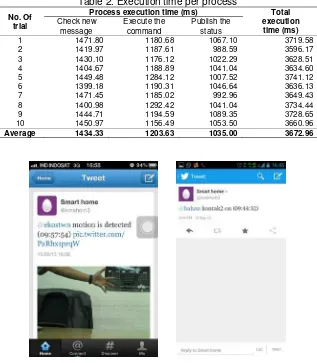DOI: 10.12928/TELKOMNIKA.v13i2.1309 678
Home Appliance Control with Publish Subscribe in
Social Media
Sabriansyah Rizqika Akbar*1, Eko Setiawan2, Achmad Basuki3
University Of Brawijaya
Jl. Veteran Malang, East Java, Phone: +62 0341 551611/ Fax:+62 0341 565420 *Corresponding author, e-mail: [email protected], [email protected], [email protected]
Abstract
Nowadays, Internet social media has enriched the way people to communicate and interract each other. Will it be possible for people to interact with their home appliances around? This paper proposes a new approach in smart home system that made possible for people to remotely interact with their appliances using social media networks. In this paper, we present a smart home prototype system that leverages Twitter’s Application Program Interface (API) to remottely control home appliances over the Internet. Experiment results showed that the system immediately responds to remote commands sent over a social media account to control home appliances. The system responds the command in 3672.96 ms. Publish-subscribe method work better in mass announcement communication system. Home system could notice all householders in less than 6 s independenly from number of householder. Our proposed method gives alternative solution to build reliable, fast and simple control method.
Keywords: Publish Subscribe, Smart Home, Social Media
1. Introduction
Smart home have several important utilitites and services parameter to be considered such as automation home appliances control and remote access [1]. Recent developments in home automation have significantly improved living of the householders to easily interact with their home appliances to adjust temperature, lighting and other devices [2],[3]. The interaction with the home appliances can even be performed remotely over the Internet or some GSM networks. The previous approaches in home automation for controlling appliances usually use a client-server system; where a client sends a message and the server do action upon receiving the message. The server must be always on to response to the message. Short Message Service (SMS) gateway and Hypertext Transfer Protocol (HTTP) are the two common ways in sending message of client-server system [2]. Even though SMS provides a simple solution of communication ways without the Internet connection, its message type is limited to text only (no picture/video). While the HTTP offers the multimedia message delivery service, it depends on an always-on Web server with a stable Internet connectivity. Moreover, HTTP that used TPC/IP network provides monitoring and controlling function easily and worldwide access [4]. Availability, security, and costs are some of issues in their deployments because we should provide and maintain the infrastructure by ourself.
the home condition, and the subscriber can send a home appliance control message via Twitter Direct messages applications. Since the subscriber can have information sent from the publisher without request to it, the subscriber doesn’t have to wait for notifications [9]. With our smart home communication infrastructure, we are not need an always-on Web server and the communication infrastructure are provided by third party social network services.
Twitter, a social media platform, provides Application Program Interface (API) that gives privilege to access user data via HTTP format. We use two kind of account in our home automation prototype: a householder account and a home system account. The home system account is connected to a home automation prototype, mainly a microcomputer with low-power processor, Rasberry-Pi. We propose to use microcomputer that combines computer and microcontroller function to communicate over TCP/IP network [4]. The prototype is equipped with a Passive Infrared (PIR) sensor as a motion detector and a High Definition (HD) USB camera to capture the home environment. An electrical load is also connected to the prototype to emulate the control system of home automation.
Overall, our home automation is able to receive control message from householder and forward the response to the control devices. Our home automation prototype will send a notification to the householder account if some motions were detected by PIR sensor. The householder is also able to control their home appliances by sending control message and responded by the electrical load. Recent home condition could be monitored by sending request captured-image to system account. Finally our research compared the complexity of packet transmission and the feature of our smart home communication mechanism with the client-server models.
2. Research Method
We designed smart home system prototype to implement Twitter publish/subscribe interactions. The prototype consist of microcomputer Raspberry pi [10] equipped with several input output device and the computer network interface. The input output device selection is based on the smart home monitoring device categorized as sensor, physiological device, and multimedia device [1]. Error! Reference source not found. described our input output device categorized as sensor and multimedia device. We put Passive Infrared Sensor (PIR) and enable Generic Purpose Input Output (GPIO) as a digital switch and electric load driver switch [11]. Our prototype is also equipped with HD camera for home monitor and captures an image event. GPIO is used for simulation purpose. Later on we put an application and Twitter Account inside the prototype to make householder able to remote the smart home systems via Twitter. PIR sensor simulate if there is intruder.
Start
User Token and Secret
Code Initialization
API Twitter User Stream
Message Received?
Run Control Command True
False
Motion
Detection True Capture & Tweet
False
Figure 2. Smart Home System Twitter API
To enable Twitter publish and subscribe system, we create publisher and subscriber Twitter account inside the system environment. Subscriber is the householder Twitter account and publisher is smart home systems account. As shown in Figure 3, we named @smahom3 as our smart home systems Twitter account. For the householder we give @hahan @ekostwn as their account. Publisher will inform all subscribers wether there is condition change in smart home system. We simulated the condition change in smart home systems in GPIO, if there is trigger from switch or passive infrared sensor, the smart home systems will publish the information to the subscribers. The subscribers will also able to change the conditions GPIO switch and an electric load by sending direct message to the smart home systems. Format message is shown in Table 1.
Table 1. Publisher Message Format
Input Event #home kamera on Capture an image from attached
camera and publish the picture to all used
#home kontak1 on #home kontak1 off #home kontak2 on #home kontak2 off
Remotely changed status in electronic load driver switch GPIO
Subscriber 1 (Householder) @hahan
Subscriber 2 (Householder) @ekostwn
Publisher (Smart Home Systems) @smahom3
Twitter Networks
Home Condition Information Home Condition
Information
Subscriber 1 (Householder) @hahan
Subscriber 2 (Householder) @ekostwn
Publisher (Smart Home Systems) @smahom3
Twitter Networks
Receive Home Appliance
Control Message Control Home Appliance Via
Twitter Direct Message
Figure 3. Smart Home systems Publish and Subscribe Scenario
3. Result and Analysis
To validate our system, we build a prototype in our laboratory as shown in Error! Reference source not found.. The system consist of Raspberry-Pi as microcomputer, GPIO interface circuit, home appliance, USB webcam, PIR sensor and push-buttons as input. GPIO interface circuit relay the low voltage of microcomputer logic to high voltage of home appliance. Using the interface circuit, microcomputer can control home appliance in different voltage. Microcomputer was connected to the internet network via Ethernet cable.
Figure 4. Smart Home systems prototype
Twitter as a “broker”, will send a notification to the home system. At the next step, home system will parse the message, decapsulation and execute based on command. Home system publish an notification via Twitter and all subcribers, who are all householders, will receive recent information about house condition without request in into system.
We examined execution time by conducting 10 trials. Each control proses consist of three main sequences. Home system check the new message, execute message and publish the report to all subscribers. The home system only need average time 3672.96 ms to read, execute and report to all householder. The experiment show that the publish and subscribe mechanism only need 1434.33 ms average time for get new data as shown in Table 2. Table 2 shows the detail of execution time per process. The execution time for check new message gained from code shown in
Figure 5. We measure the time between the message come to our system, parsing the string as variables and turn on ACT led as an indicator whether a message started with ‘#home” format had arrived.
Figure 5. Execution Time Code for Check New Message
We also measure the average time needed to execute a relay switch. The execute command execution time code shown in
Figure 6. Execution Time Code for Execute Command Table 2. Execution time per process
No. Of trial
Process execution time (ms) Total
execution time (ms) Check new
message
Execute the command
Publish the status
1 1471.80 1180.68 1067.10 3719.58 2 1419.97 1187.61 988.59 3596.17 3 1430.10 1176.12 1022.29 3628.51 4 1404.67 1188.89 1041.04 3634.60 5 1449.48 1284.12 1007.52 3741.12 6 1399.18 1190.31 1046.64 3636.13 7 1471.45 1185.02 992.96 3649.43 8 1400.98 1292.42 1041.04 3734.44 9 1444.71 1194.59 1089.35 3728.65 10 1450.97 1156.49 1053.50 3660.96
and publish the report by mentioned all user. Some notification will received on user smartphone. We test on IOS and Android operating system smartphone, shown in
Figure 7. Timer start to be counted when first user send command. Timer stop when all user already received the notification. Error! Reference source not found. show correlation between execution time on user-side and number of user.
Figure 8. Time response in multiple subscriber Table 3. Client-server and publish-subscribe comparison
No Feature Client-server Publish-subscribe
1 Always-on host
Required. Always-on host must exist as server. When client send request, server must be on or it will lost the information
Not compulsory. Owner can sent command even home system is off. The command will be stored in broker and it will automatically downloaded when home system is on.
2 IP public
Required. Server or home system must have unique IP public to be able receive request
Not required. IP address can be changed dynamically. Householder can send command even the IP address is changed
3 Network
maintenance Require periodic maintenance. Already handled by third party broker.
4 Time of transfer
Depend on number of client. Many householders will require much time to transfer
Short and not depend on householder. System can send to householder at the same time
5 Security System design can determime the level of its security
Network security depent on broker management
Based on Error! Reference source not found., it show that the number of subscriber did not take effect on execution time. Publish subscribe system deliver the short execution time for multiple user. Incremental of execution time was not slightly different between each number of user. This happen due to parallel process at each user. One user in publish subscribe system created connection to the “broker” separatelly. Every process was handle by Twitter as a “broker”. Home system also create its own connection to Twitter. When some update occured by home system, every user was notified the change by Twitter parallely.
Finally, Our research compare client-server system to publish-subscribe system. Each point of view is described on Table 3. Based on Table 3, the publish-subcribe mechanism give more advantages than client-server. Publish-subcribe provide a better communication way. Publish-subscribe has high-dependently to the “broker” system. Selection of better and stable “broker” will ensure lifetime system longger. Client-server system is more independent system than publish-subcribe. Our proposed method show the better system in handling mass communication.
4. Conclusion
infrastructure with high capability in handling mass communication. Selection of good broker service is very important in publish-subscribe lifetime.
As part of future research, data encryption in publish-subcribe should be conducted. Building encription system will keep secret data flowing in public system. Learning the behavioral of householder via its publish will provide a smart system. The home system will understand desire without saying anything.
References
[1] MR Alam, MBI Reaz, MAM Ali. A Review of Smart Homes—Past, Present, and Future. IEEE Transactions On Systems, Man, and Cybernetics. 2012; 42(6): 1190-1203.
[2] V Ahmed, S Ladhake. Novel Low Cost Remote Monitoring System for Home Automation using Cell Phone. International Conference on Computing Intelligence and Communication System, Gwalior. 2011.
[3] M Chan, D Estève, C Escriba, E Campo. A review of smart homes—Present state and future challenges. Computer Methods and Programs in Biomedicine. 2008;91(1): 55-81.
[4] Ashari. Distributed Monitoring and Controlling Using Microcontroller and Virtual Internet Protocol.
TELKOMNIKA Telecommunication Computing Electronics and Control. 2010; 8(2): 285-292.
[5] Ross EO, M Sisic, J Arseneault, M Simmering, R Orr. Personality and motivations associated with Facebook use. Computers in Human Behavior. 2009; 25: 578-586.
[6] K Curran, S Morisson, S McCauley. Google+ vs Facebook: The Comparison. TELKOMNIKA Telecommunication Computing Electronics and Control. 2012, 10(2): 379-388.
[7] Bell TK, S Lauria, R Macredie, J Sutton. Microblogging as a mechanism for human–robot interaction.
Knowledge-Based Systems. 2014; 69: 64-77.
[8] NA Gamagedara A, L Stanislao, S Love. Twitter Controls the Household Heating System.
International Journal of Sustainable Energy Development (IJSED). 2013; 2(3/4): 101-104.
[9] A Virgillito. Publish/Subscribe Communication Systems: from Models to Applications. Universit'a degli Studi di Roma "La Sapienza" Dipartimento di Informatica e Sistemistica, Roma. 2003.
[10] Rasperry Pi Foundation. Raspberry pi. [Online]. Available: http://www.raspberrypi.org/. [Acesso em 12 December 2014].





